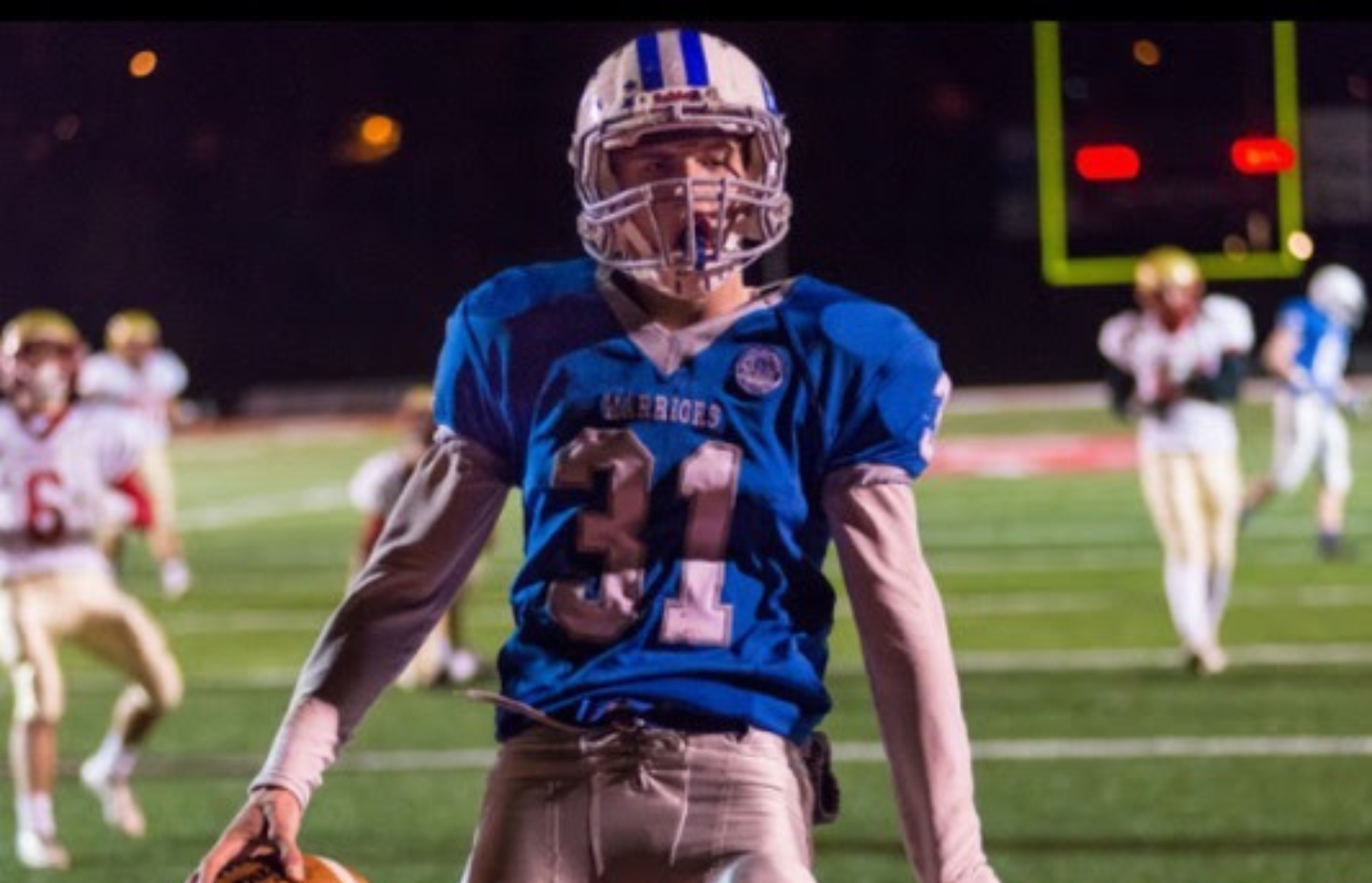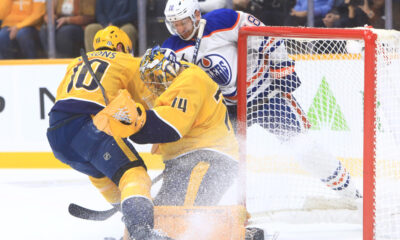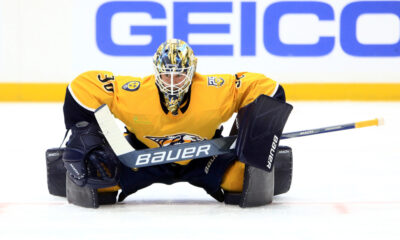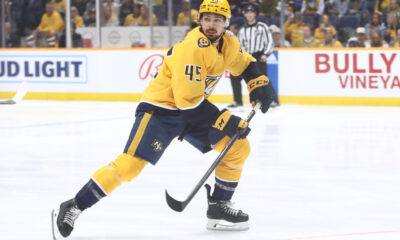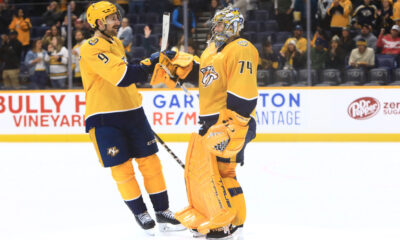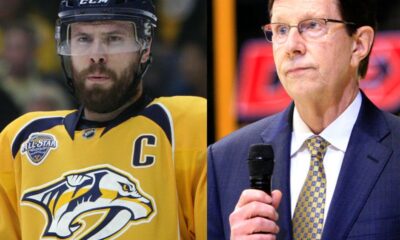On November 16th, 2013, at the Metrodome in Minneapolis, the semi-final round of the Minnesota State High School Football 5A Championship was about to kick off.
With a trip to the 5A state final on the line between Brainerd and Chaska, Brainerd safety Cole Smith fielded the opening kickoff at the 21 yard line.
He made one cut to the outside and sprinted 79 yards for the score, untouched.
It was a key moment for the Warriors and fueled their 20-19 win over Chaska, earning them a spot in the 5A state final.
“They kicked it off to him, he got it, made one turn, and was gone,” says Cole’s father Tom Smith. “It got us on the board right on the opening kickoff, it was a big play.”
For Cole Smith, love for hockey has always been shared equally by love for football, a sport he grew up admiring because of his family’s rich history with the sport (“it’s in our blood”) and its constant presence in his life from an early age.
“Football was my first love,” Smith says.
And if it wasn’t for that first love and eventual obsession with football, Smith might not be the professional hockey player he is today.
Cole Smith’s first love? Football.
“Our town was a football town,” Smith tells me. “Obviously, hockey’s grown there quite a bit too, but we grew up with football. My dad was a football player, he played at St. Cloud State. My uncle played, my grandpa played as well, my whole family played.”
Growing up in Brainerd, Minnesota, Smith knew how important football was to his family and community.
Cole’s father Tom Smith and his uncle P.J Smith played for nearby St. Cloud State University in the mid-1980s. The Smith brothers were the two starting cornerbacks for the Huskies in ’84 and ’85, with Tom earning first-team All-NCC honors in ’85. Then there was Cole’s grandfather, Pat Smith, a Brainerd athletics legend in his own right.
A few years after Tom Smith’s football playing career ended, he became a coach at a nearby high school. Then in 1995, Cole was born and it wasn’t long before Tom started bringing him to football practice.
“He was around three or four years old when I started bringing him around to practice,” Tom says. “He saw his dad was into football, so that’s probably why he was into it.”
Of course, hockey was present in Cole’s life as well. He learned to skate as a kid, as most Minnesotans do, plus his other uncle, Sandy Smith, was an accomplished hockey player at University of Minnesota-Duluth. He was drafted by the Pittsburgh Penguins in ’86, and played professionally for several IHL teams in the ’90’s.
Still… Cole Smith loved football more than hockey as a kid.
“I remember when my sister Gabbie was born in 2001,” Cole recalls, “I had on a full [New England] Patriots uniform and was carrying a [Carolina] Panthers football. I have a picture of it somewhere, I was really into it.”
Smith’s love of football eventually led to a four-year stint at Brainerd High, playing for the Warriors on Friday nights. Though he played wide receiver occasionally, he excelled as a defensive back/safety.
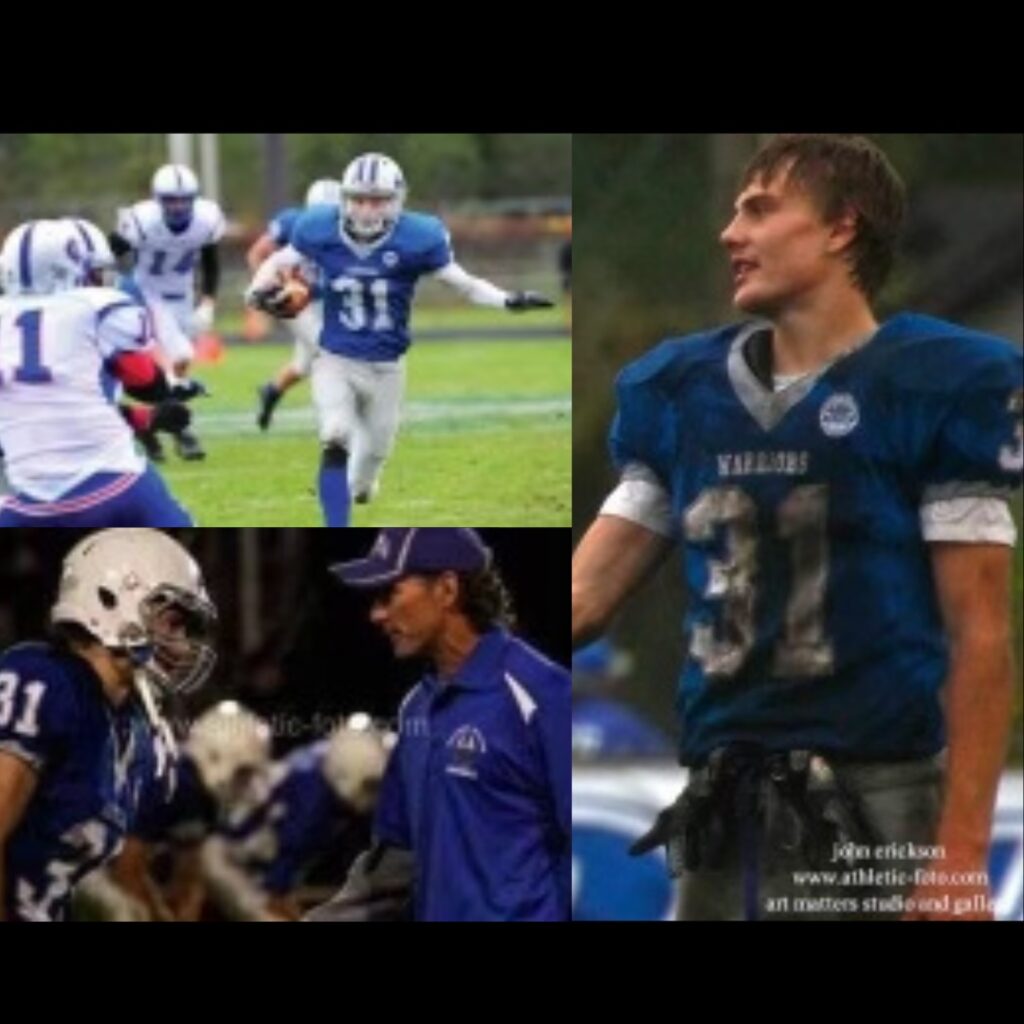
“Defense was more fun,” Smith says. “That was my spot, I enjoyed it. I was kind of the quarterback of the defense my senior year, so that made it even more fun. It was challenging out there, and obviously you got to hit guys a little, too.”
Smith made All-Conference as a safety his junior (2012) and senior (2013) seasons, while also scoring several touchdowns on punt and kick returns. He played wide receiver, and though he says he only played sparingly, he led the team in receiving as a junior with 231 yards.
Smith’s strenuous schedule as a senior
Hockey gained more interest from Smith as high school progressed. He put up 41 points in 23 games his senior year for the Warriors, capping off an excellent four year career on the ice.
At some point he added Elite League Hockey to the mix, an inter-state premier high school development program for those looking to make the jump to the next level. That’s when Smith really began to excel in the sport… and when his sports schedule became more grueling.
“He had a heck of a schedule going on,” his father Tom says.
A typical sports weekend schedule for Cole Smith in high school was unimaginably busy. He played football on Friday nights, followed by an overnight drive south to play ultra competitive hockey in various cities around Minnesota and Iowa.

“As soon as the [football] game would be over, he would be all beat up, because he played a lot,” Tom says. “A lot of guys would go out after the game or just head home, but we jumped in the car as soon as the game got over, and I’d drive him to some other city, wherever the [hockey] games were.”
Saturday and Sunday were both full of intense hockey games, with not much downtime. Then, on Sunday nights, him and his father would drive back home to Brainerd for school the next day and be right back on the football practice field that afternoon.
“I feel like I had him in over his head sometimes, but he was really grinding it out,” Tom says. “He loved it.”
Smith’s path to pro hockey was full of challenges
By Smith’s senior year, he was leaning towards continuing his hockey career rather than sticking with football. Cole says his father never pressured him toward either sport (“he just wanted the best for me, to be best that I could be”, Cole says), but his dad says they had discussions about choosing hockey over football.
“I was kind of pushing him [towards hockey],” Tom says. “I just thought the best chance of playing at a high level of college, and maybe a little bit after, would probably be hockey. I had played football all my life and I was worried about him getting hurt.”
With as violent as football can be, Tom says it was a bit of a relief when he went to hockey, because the injury concerns weren’t as prevalent.
“That senior year… he hardly left the field. He was playing both ways. It was a kind of a catch-22… every time we won a game, it was great. But then I also knew that we had one more game after that. I just wanted him to get out of it healthy, you know?”
After high school, Cole Smith was drafted by the Sioux Falls Stampede out of the USHL. Unfortunately for Smith, tryouts for the Stampede happened the same weekend as the Minnesota State High School Track Meet. Smith was an important member of Brainerd’s 4×100 and 4×200 relay teams, and there was no way he was abandoning his teammates.
Running back and forth between a USHL tryout and the Minnesota State Track Meet ended up being too much. He was one of the last forwards cut from the Stampedes.
So instead he played junior hockey for the Steinbach Pistons in the rough-and-tumble Manitoba Junior Hockey League (MJHL). The goal was to develop quick enough to find a spot on a college hockey team, but the first year in the MJHL was tough for Cole.

“It was a tough move for him to move to Canada,” Tom says. “He was living in a small Mennonite community, there wasn’t much to do there. It was really his first time away from home, and I had to get after him pretty good for a while and just say, ‘hey, you’re there, suck it up… make the best of it.'”
In addition to his father’s words of encouragement, Cole Smith had coach Paul Dyck on his side. A longtime family friend of the Smith’s, Dyck worked directly with Cole at Steinbach to develop his game enough so he could play college hockey.
And it worked. Two years later, Cole Smith enrolled at the University of North Dakota, one of the premier collegiate programs in the country.
A four year starter for the Fighting Hawks, Smith honed his defensive-first approach, playing a physical style of hockey that “always focused on the little things” according to his dad. Getting pucks from the defensive zone and into the offensive zone. Fighting for loose pucks in the corners. Forcing skilled opponents to make poor decisions with the puck when pressured with speed and aggression. All the usual things you’d expect from a defensive-minded forward.
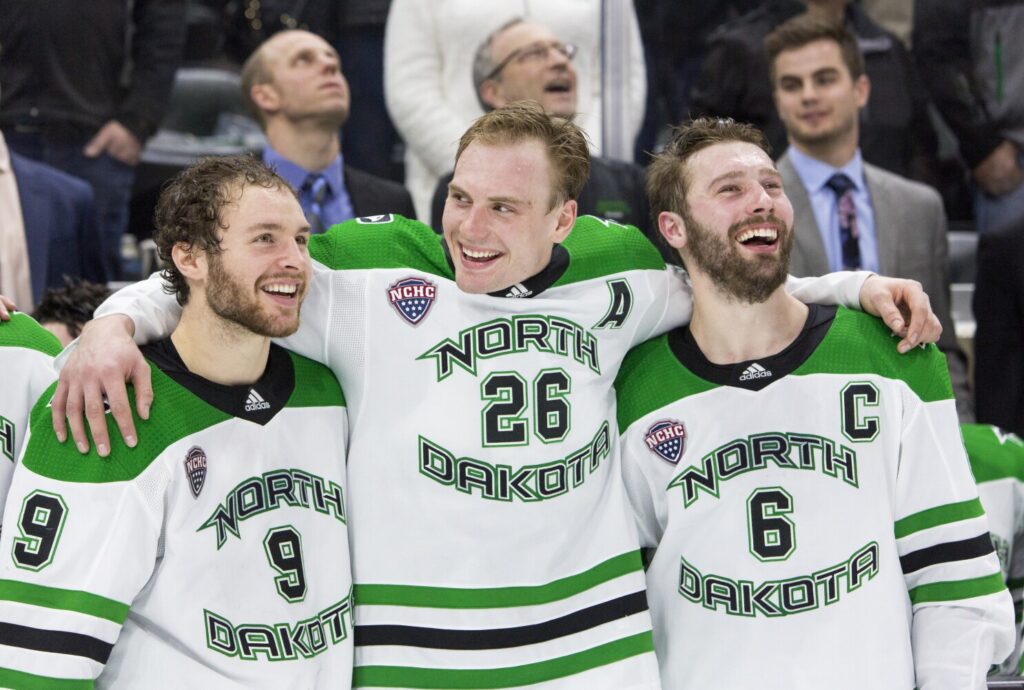
“[Cole] does a lot of things that go unnoticed,” Tom says. “But it’s like my brother always told him, the people that really matter are gonna see, they are going to see how effective you are.”
Playing over 120 games of elite college hockey, and doing “all the little things” along the way, rounded out Smith’s game, It also prepared him physically for playing professional hockey. So, after college, Smith found an agent, Dean Grillo, to help gauge interest from NHL teams.
The New York Rangers had some interest, but it was the Nashville Predators who signed him to a deal in March of 2020.
Predators Assistant General Manager Jeff Kealty had high praise for Cole Smith when they signed him.
“If you talk to the people at North Dakota, they just rave about the character traits that he has – his competitiveness, his drive, his physicality, all those ingredients he adds to a team in a winning environment. We feel like he’s going to be able to add all of that to our organization.”
A circuitous route to Nashville
Smith’s first professional season in 2020-21 was complicated, like most things were, by the COVID-19 pandemic. He made the Preds roster out of training camp and made a quiet NHL debut on January 14th, against Columbus, but didn’t stay up long. He spent time with the Florida Everblades (ECHL) and the Chicago Wolves (AHL) with a combined roster of Predators and Hurricanes prospects.
The following season, when the NHL world was mostly returning to normal, Smith played 59 games for the Milwaukee Admirals, scoring 21 goals and 20 assists. Then in 2022, he played nearly a full season for the Preds, putting up 17 points in 69 games while playing a heavy defensive role for Nashville.
Though his first full season was not without controversy, Smith’s role on the team was an important one. Smith played alongside Tanner Jeannot on a penalty kill unit that ranked 6th best in the NHL. With Smith on the ice during the kill, the team allowed 91.7 shot attempts per hour, which ranked 2nd best on the team behind Yakov Trenin.
His four goals were seen as a personal affront to many Predators fans who wanted Finnish goal scorer Eeli Tolvanen in Nashville. Things were only made worse when the organization waived Tolvanen in December, only to see him claimed by Seattle and then become an instant hit with the Kraken.
Meanwhile, Smith didn’t score his first goal of the season for the Preds until January 21st against Los Angeles. By that point, Tolvanen already had five goals for Seattle.
But blaming Cole Smith for the errors the organization made with Tolvanen is a bit unfair. Two different players with two different roles and two different sets of expectations.
Smith is a defensively skilled player with a lot of size and speed. Tolvanen is a crafty sniper with a penchant for goal scoring, especially on the power play. The team needed both at the time, for better or for worse. Unfortunately, they made a poor management decision in waiving Tolvanen, but that’s hardly Smith’s fault.
When football film study pays off
As a defensive back in high school, Cole Smith spent many hours looking at film. His dad took on the role of video coach, helping break down film to get better in the secondary.
“He and I would watch film together,” Tom says, “Show him to not look into the backfield, to look at what the linesmen are doing, where they line up, where they place their hands. We got pretty good at it.”
Cole says his dad would spend most of his free time (he was a physical education teacher) every Monday breaking down 10-20 clips of film together.
“If you can get some good film sessions in with your reads, it helps big time” Cole says.
Today, you can see that film work in action with Smith in NHL games. Reading opponents as they skate down the ice, reading their hips and feet, anticipating where the gap is going to be, making movements toward the outside to force the player to the wall. Even more advanced defensive tricks like peeling off a defensive read slightly in order to lure a bad pass, then jumping on the puck for an interception.
You know, the kind of move a safety might pull on a wide receiver.
Smith’s speed and athleticism leading to good results
Andrew Brunette isn’t surprised Cole Smith was a football player in high school.
“He’s extremely athletic,” Brunette tells me. “And with his size and his reach, I could see him as a wide receiver. I could totally see that, he’s very athletic. We played pickleball at the start of the year. He covered about three courts. With his explosiveness, how he jumps, you can see it.”
Under Andrew Brunette, Smith’s ice time has increased by nearly a minute per game (from 12:45 last year to 13:35 this year) and he leads the team in penalty kill minutes per game among forwards. He’s even improved his offensive production, scoring a career high five goals in his first 33 games.
“You can see in hockey where he’s got the speed, he’s got the length,” Brunette said, who has been matching Smith with Yakov Trenin and Colton Sissons mostly at five on five. Smith and Sissons are a steady presence on the penalty kill, helping force turnovers at the blueline, which has led to three shorthanded goals between them.

Cole Smith doesn’t seem to be approaching the game any differently this year than he did last year, but he’s seen almost double the point production: 15 points in 33 games this year, compared to 17 points in 69 games last year.
However, just like any good defensive back, Cole has a short memory. Even after good plays.
“Just put your head down and try to work and stay true to yourself,” Smith said at one point last year. “Hopefully good things come out of it.”
And now, some 10 years after taking the opening kickoff to the house for Brainerd, good things are happening again for Cole Smith on the Nashville Predators.
— Images courtesy of Cole Smith, the Steinbach Pistons, and Nick Nelson / Grand Forks Herald —
This article sponsored by Sallis Realty Group

